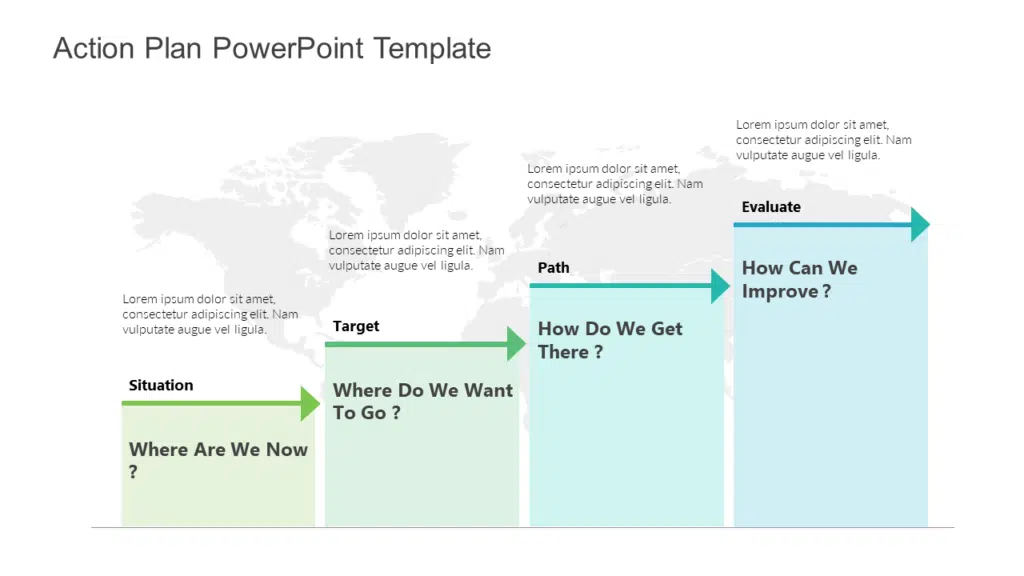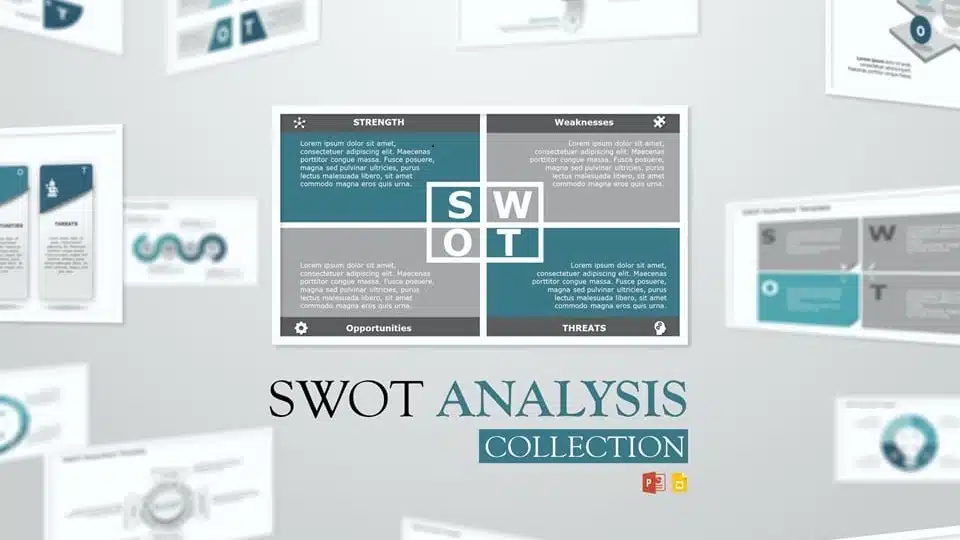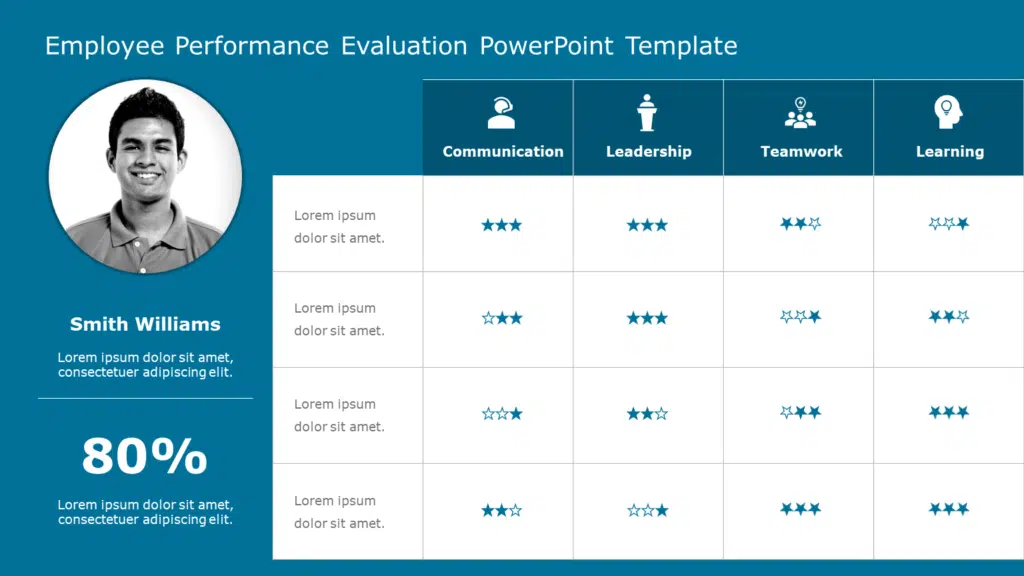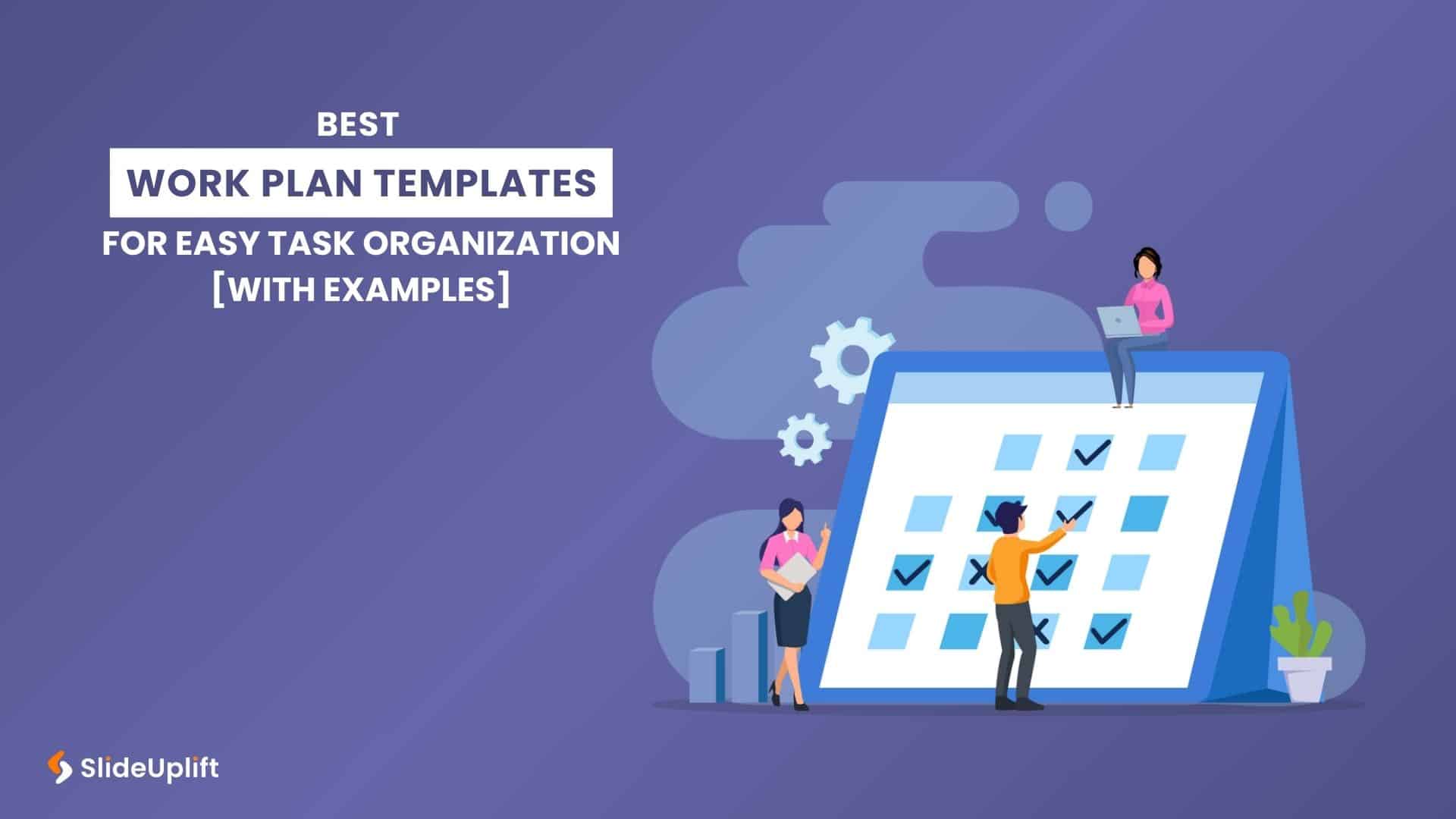Detailed Guide For Start Stop Continue Retrospective [With Examples & Exercises]
A lot of people find it challenging to provide and accept constructive criticism. Why? Because receiving criticism can be awkward. It might be uncomfortable to criticize your team’s performance, and it can be difficult to hear critical comments about your performance. Start Stop Continue retrospective is the solution for this.
Giving candid feedback can be uncomfortable, so many managers put it off. They know feedback can help their team perform better. Still, they fear it will have the opposite impact and lower performance if misinterpreted and sets off a fight-or-flight reaction.
Wouldn’t it be fantastic if you could use a straightforward tool to overcome these obstacles and boost teamwork and productivity? Start Stop Continue can be your ideal tool. Therefore, this article will provide a detailed explanation of retrospective start stop continue examples.
What is Start Stop Continue Retrospective?
The start-stop-continue method is one team reflection meeting technique utilized in agile project management. At this meeting, the team decides what needs to start, stop, and carry forward from the last sprint or iteration. It is done before moving on to the following sprint.
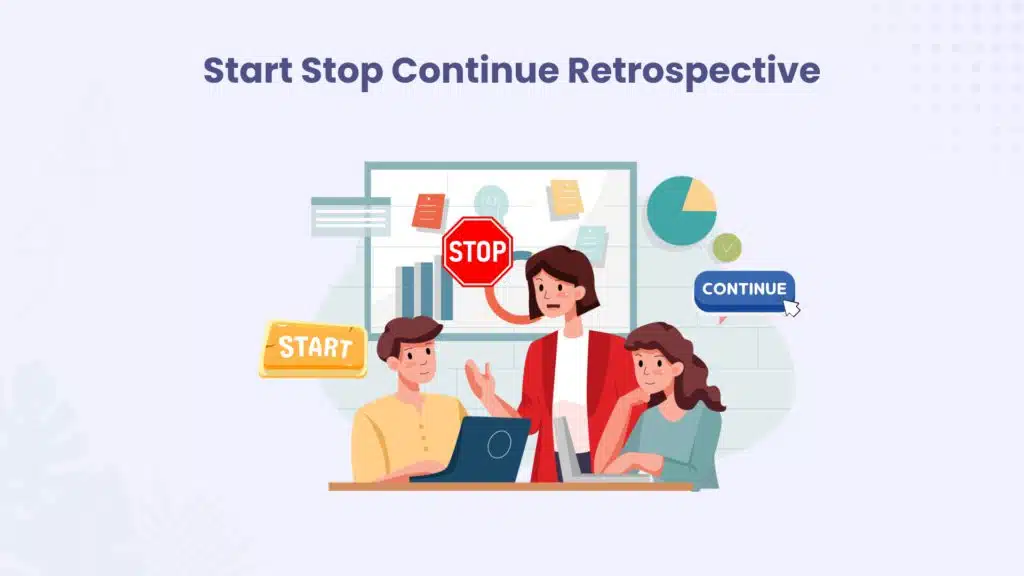
Asking coworkers or employees for feedback is easy and effective when you use the Start-Stop-Continue method. Polaroid devised this exercise as an internal team-building tactic in the 1970s, giving rise to the concept.
Participants can give organized, anonymous feedback by using this strategy. Each participant in the exercise is asked to recommend one action the team should take moving forward, one action the team should abandon, and one action the team should start. The replies are gathered and discussed during group meetings to help teams evaluate their existing circumstances and pinpoint growth opportunities.
The Three Elements of Start Stop Continue Retrospective
Three elements, topics, or questions that are covered in this approach are:
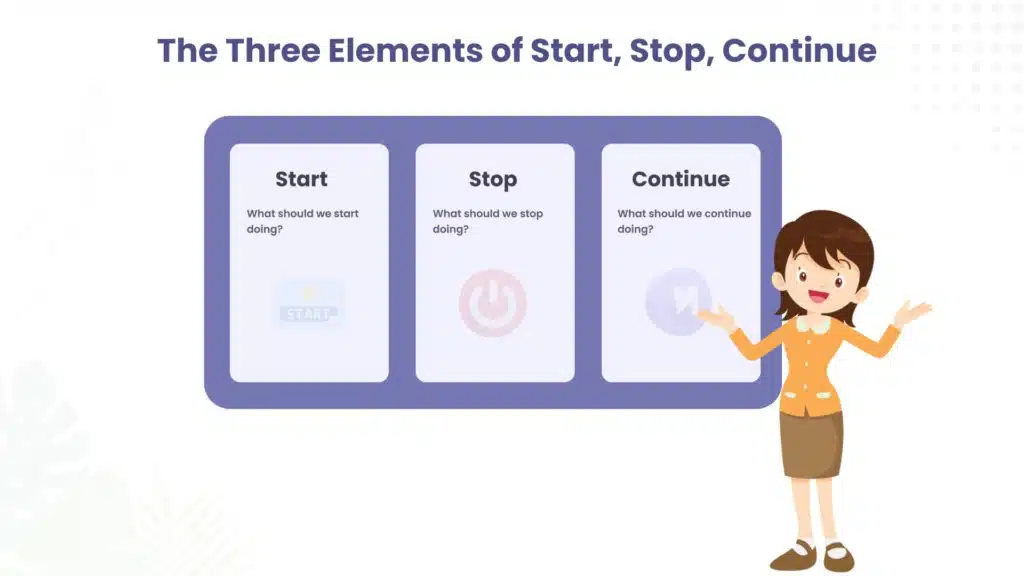
Start: In the next retrospective, what new task should the team take on that they aren’t already performing? It can involve suggesting new approaches, procedures, or equipment that the team believes will improve their job or finding solutions to existing issues.
Stop: What is the group doing now that needs to be stopped? It can include anything impeding the team’s progress or placing undue burden on it.
Continue: What is the team doing that is improving the project and should be kept going? It facilitates acknowledging accomplishments. It can also relate to assignments where the team wants to keep going even when unsure of the outcome.
Why use the Start Stop Continue Retrospective?
Here are a few reasons why you should start using the stop start continue analysis in your organization:
- Provide reviews: The “Start, Stop, and Continue” analysis gives group members practical feedback on improving their efficacy individually and collectively.
- Finding places for improvement: Managers and leaders can identify new areas for development and explain group issues using the start, stop, and continue analysis. You can create workable strategies and doable tactics to change behavior upon identifying the areas that need improvement.
- Empowers and unites people: Start, stop, and continue approach enables individuals and teams to improve their work processes and workflow continuously. It gives them a perspective and lets them determine what is ineffective and what they should begin doing to accomplish their objectives.
- Develops Self-Awareness and Trust: Creating a team with consensus and individual self-awareness is crucial for efficient work processes and project success. Furthermore, the start, stop, and continue framework is excellent for helping people become more self-aware and building team members’ beliefs.
- Leads to a change in behavior: Teams can examine their prior work and quickly identify actionable items to focus on individually and as a group using the start, stop, and continue technique.
When should you use the Start Stop Continue Exercise?
The stop start continue exercise has the advantage of being applicable in a variety of scenarios, such as:
1. The beginning of a new year
A start-stop-continue is a terrific method to get your team thinking about improving and making the upcoming year better than the previous one, whether it’s the start of the calendar year or your company’s fiscal year.
2. Errors
Use the stop-start-continue exercise with your team if you need to address a pattern of mistakes but want to maintain their trust in the process. Find out what they could begin doing, what they could stop doing, and what they could continue to ensure the error doesn’t happen again. This strategy focuses everyone on going forward and acting instead of concentrating on the mistake.
3. Initiative for Change
It’s a good idea to go through the stop-start-continue exercise with your team when introducing and implementing a change project. Hence, know what needs to start, halt, and continue to execute the change correctly. Furthermore, this exercise facilitates change adoption, involving employees directly adjusting their workloads.
4. Inadequate Work
You can also use the stop-start-continue method to assist your team in determining why they aren’t meeting their objectives and what they can do to improve.
5. Annual Planning
Use the start-stop-continue exercise to assist your team in decision-making throughout the time you perform your annual planning, set budgets, and define goals.
How to Conduct the Start Stop Continue Analysis?
Follow these steps to plan a stop start continue exercise:
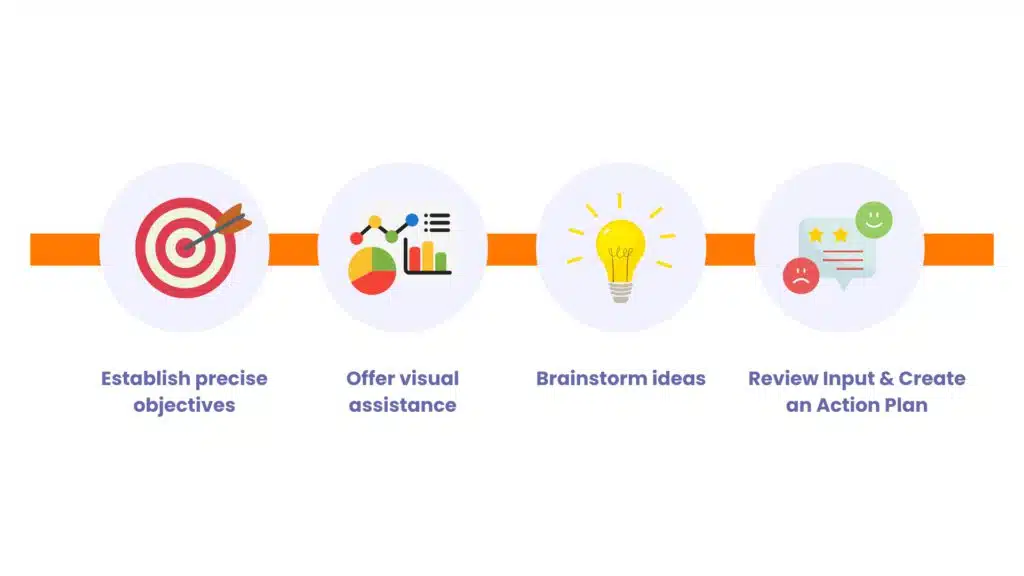
1. Establish precise objectives for the procedure
Clearly state your goals for the process and outline what start, stop, and continue to comprise. To determine if you should adjust your strategy, you could inform your staff that you want to examine how you handle customer orders. To ensure you get all the ideas, encourage everyone to reflect on themselves and prepare beforehand. In addition, provide a detailed description of the topic matter and format and a long-ahead invitation to participants.
2. Offer visual assistance
Give everyone something to look at and focus on once you’ve gathered them all together. A shared spreadsheet, a whiteboard, or sticky notes can be used as a visual aid to help group ideas and make connections between them. Make the presentation interactive if you plan to include one in your reflection process.
3. Brainstorm ideas
Work together to discuss and implement the ideas. Several team members frequently express the same concerns or have comparable thoughts. Next, organize a brainstorming workshop to determine how to implement these concepts best.
4. Review Input and create an Action Plan
The last stage is to create an action plan after assessing the important ideas generated during the brainstorming session. Based on the input, set SMART goals and develop an appropriate action plan to reach the goals.
Start Stop Continue Examples
Example 1: Using Stop Start Continue Examples to Increase Your Effectiveness
Here’s an example of how recognizing the Stop Start Continue behaviors can help you become more effective:
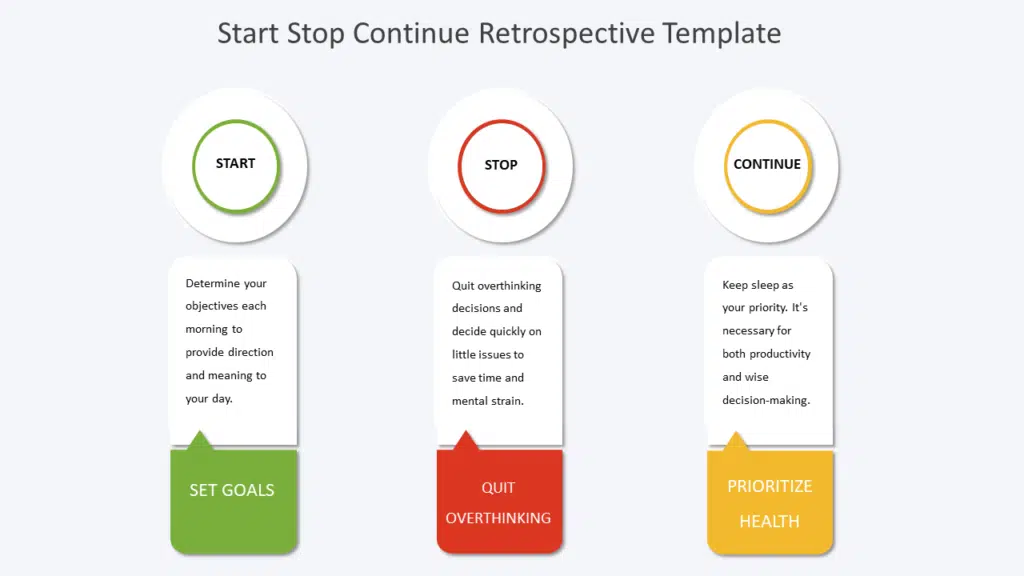
Start:
- Determine your objectives each morning to provide direction and meaning to your day.
- Engage in active listening by giving the speaker your attention, enhancing relationships and understanding.
- Exercise regularly; even 15 minutes daily can improve mental and physical clarity.
- Set aside time weekly to expand your knowledge and skill set by learning something new.
- Assign jobs that others can complete so that you may concentrate on high-priority projects.
Stop:
- Quit overthinking decisions and decide quickly on little issues to save time and mental strain.
- Positive affirmations can replace negative ideas, increasing motivation and self-assurance.
- To free up additional time, politely decline meetings that don’t need your participation or presence.
- Acquire the ability to decline requests that conflict with your aims and objectives.
- Steer clear of working late hours regularly; effectiveness and balance depend on personal time.
Continue:
- Keep sleep as your priority. It’s necessary for both productivity and wise decision-making.
- A clean environment promotes mental clarity.
- Strong networks are the secret to success and personal development.
- Establish work and leisure time boundaries to preserve a healthy work-life balance.
- Maintaining your goals align with your abilities and desires requires regular evaluation and adjustment.
Example 2: Using Stop Start Continue Examples to Master Your Productivity
Here’s another start stop continue examples of how recognizing the Start, Stop, and Continue behaviors can help you increase productivity:
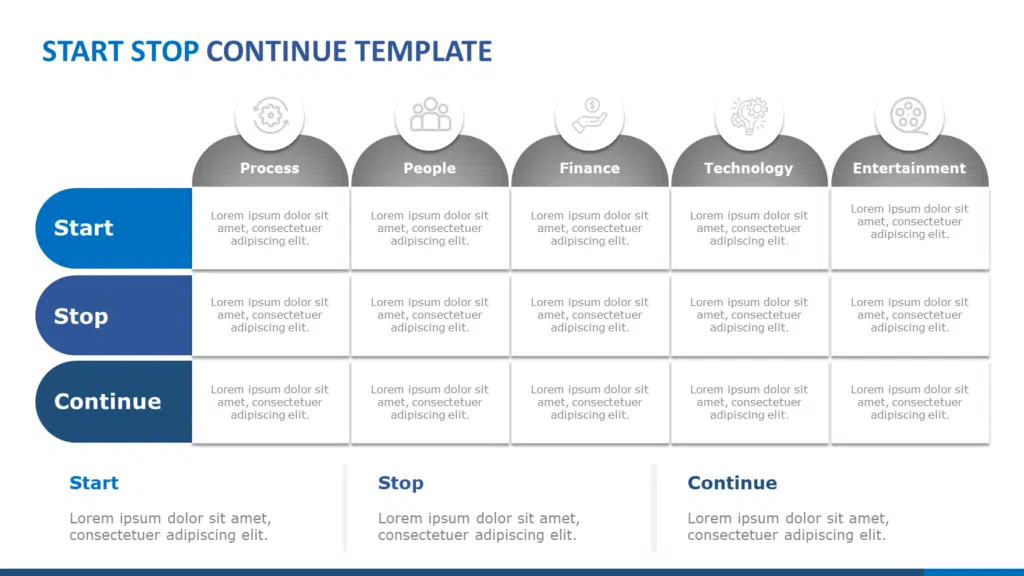
Start:
- Use a timer for your work sessions to overcome procrastination and retain attention. Set it for 25 minutes of concentrated work, followed by a 5-minute break.
- To maintain clarity of priorities and avoid overload, list the top three things you need to get done each morning.
- Organize your day in five minutes every morning to improve time management and lower worry.
- Every hour, include five to ten-minute breaks to sustain energy and prevent burnout.
- Engage in ten minutes daily in physical activity to increase motivation and vitality.
Stop:
- Give one task your whole attention to increase efficiency and concentration. Quit multitasking.
- To be more productive, dedicate the first hour of your day to your most crucial work.
- If a task or obligation doesn’t fit your priorities or your current ability to manage your time effectively, politely decline it.
- Rest thoroughly during lunch to clear your head and prevent afternoon energy slumps. Don’t work through lunch.
- Start projects even when conditions aren’t optimal to overcome procrastination.
Continue:
- After each day, keep your workstation organized. A neat workstation encourages mental clarity and preparedness for the following day.
- Keep track of deadlines and priorities by regularly updating and reviewing your to-do list.
- Be willing to attempt various approaches to see what suits your style the best.
- Make a note of your most productive times of the day and make an effort to plan critical chores for these periods.
- Noticing a small act of gratitude at the end of each day can help with perspective and motivation in general.
Template for Start Stop Continue Retrospective
You must have understood the concept with start stop continue examples. However, it might be time-consuming and hectic for you to create presentations from scratch. That’s why we have created PowerPoint Presentation Templates for you to start with. Because of its adaptability, you can apply the Stop Start Continue template in various contexts, such as organizational reviews, team meetings, project retrospectives, and individual introspection. It promotes self-awareness, constructive criticism, and a never-ending growth mindset.
Three separate sections comprise the template:
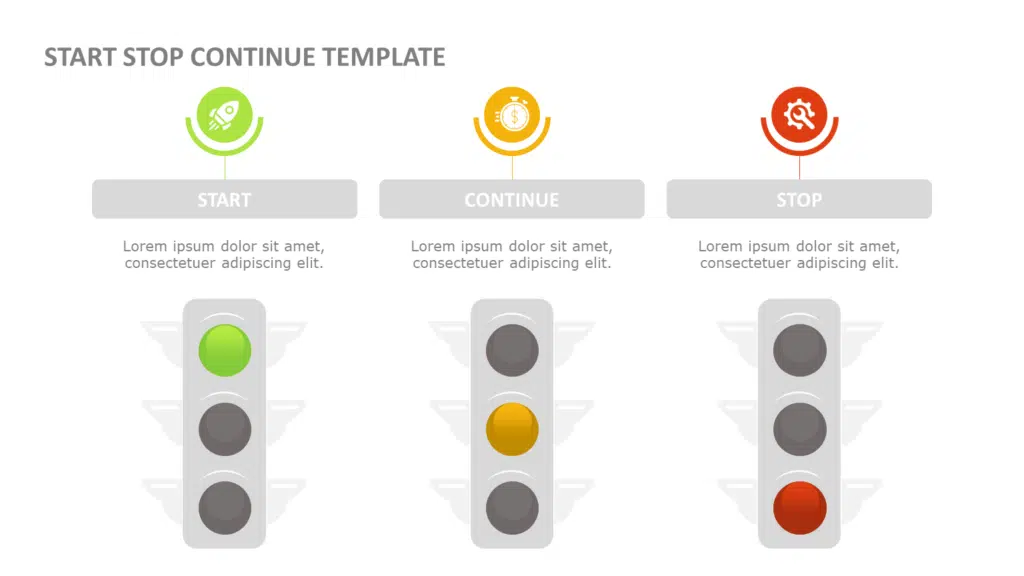
Start:
Aim: The aim is to ascertain novel approaches, conduct, or tactics that ought to be employed.
Focus: Investigating underutilized potential, creative concepts, and possible behavioral and process enhancements.
Questions/Statements: These usually include invitations to consider novel methods, instruments, or strategies to improve results or performance.
Stop:
Aim: The goal is to identify and eliminate any actions, attitudes, or procedures that are harmful, outmoded, or unproductive in subsequent retrospectives.
Focus: On rigorous evaluation to determine what is impeding advancement or effectiveness.
Questions/Statements: centered on determining which behaviors, attitudes, or habits must be altered or abandoned.
Continue:
Aim: To uphold and strengthen the currently implemented, successful procedures.
Emphasis: On recognizing and maintaining what functions well.
Questions/Statements: Seek to determine and promote the maintenance of effective tactics, actions, and procedures.
How to present Start Stop Continue Retrospective
After your group has used the “Start Stop Continue” method to examine important issues, it’s time to put your findings into practice! The following steps will help you place the conclusions from a design retrospective PowerPoint Presentation into practice:
- Key Findings: Note the most important conclusions and insights from the retrospective meeting. The team uses this material as a guide to avoid missing the identified opportunities and problems.
- Sort Results by Priority: Sort the found results into priority lists according to how they will affect the project and how simple it will be to implement. To get the most out of the changes, concentrate on solving the most critical problems first.
- Describe Doable Steps: Provide precise, doable actions that can be performed to rectify or enhance the situation for each finding. Give detailed instructions on what needs to change, who should do it, and the intended results. The terms “stop,” “start,” and “continue” might be used to clarify these activities further.
- Assign Tasks: Assign roles to carry out the specified actions. Ensure that everyone in the team understands their roles and duties and how they contribute to the improvement process.
- Track Development: Regularly monitor the development of implementation efforts. Monitor the team’s compliance with the specified action items and whether they have made the intended changes. Ask team members for comments regularly.
- Think Back in Upcoming Retrospectives: Consider how well the implemented adjustments worked in subsequent retrospectives. Determine whether the enhancements had the desired effect and pinpoint any more areas that need improvement.
Tips to run your Start Stop Continue Analysis Smoothly
Providing feedback is a science and an art in equal measure. The following tips can help your stop start continue feedback session run more smoothly:
- Be Specific: People may need clarification about the changes they must make due to vague criticism. Please provide as much detail as possible about what they should begin, pause, and continue. Provide precise examples to support your arguments.
- Be Objective: When providing feedback, set aside your emotions. Please pay attention to how a person behaves and affects the group and the company.
- Be Respectful: You need to voice criticism in a considerate manner. Keep your words, tone, and timing in mind. Nonetheless, supporting the person’s development would be better than insulting or humiliating them.
Alternatives of Start Stop Continue Exercise
Even though the Start Stop Continue exercise is quite popular, it might get boring after a while. Beyond just being boring, too much monotony can have serious adverse effects. For this reason, we’ve provided you with a few appropriate substitutes below to stop this boredom before it starts.
The Start Stop Continue Retrospective has a strong emphasis on activity optimization. Nevertheless, agile working encompasses far more than just “optimizing activities.”
- Using the Mad Sad Glad Retrospective, for instance, you can examine more closely the unfavorable feelings that the team has during a lean moment.
- Furthermore, a retro, such as the DAKI (Drop Add Keep Improve), broadens the horizon by adding another intriguing dimension to the Start Stop Continue exercise.
- You can also take a lighter approach to a throwback and go for something like the Soccer Retrospective.
Any agile organization must have sprint retrospectives, such as Start Stop Continue, because they enable teams to convene regularly, assess their progress, and make plans simultaneously.
Conclusion
If you’re trying to simplify your life, then the Start Stop Continue Retrospective is just what you require. Although this is a simple activity, the result is a prioritized list of action items prepared for the following period’s implementation. It can take your daily organizational activities to the top.
FAQs
-
Who should participate in a Start Stop Continue exercise?
Ideally, all team members involved in the project or iteration should participate to ensure diverse perspectives and insights are considered
-
What is the purpose of a Start, Stop, Continue Retrospective?
The purpose is to reflect on past performance and identify what practices or behaviors should be started, stopped or continued to improve future outcomes.
-
How often should I use the Start, Stop, Continue Retrospective?
Start, Stop, Continue Retrospective can be done at the end of each iteration or project cycle to reflect on what should be started, stopped, or continued.
-
How do you facilitate Start, Stop, Continue Retrospective?
You can facilitate Start, Stop, and Continue by setting clear goals, creating a safe environment for open discussion, using visual aids like a whiteboard or sticky notes, and encouraging participation from all team members.
-
How do I ensure actions identified in the Start, Stop, Continue Retrospective are implemented?
Assign responsibility for each action item, set deadlines, and regularly track progress during subsequent team meetings or iterations.

